Helpful Pictures
by George Nenadovich, Vinni Vondera, Gary Fanning
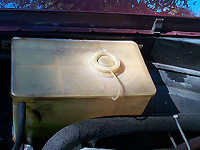
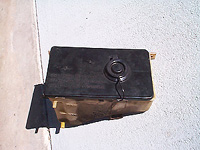 The radiator overflow bottle on the left is found in early
1970 Skylarks. It has a translucent top while later versions, 1971-2, have
black tops. Sometime in 1970, the black top verisons appeared.
The radiator overflow bottle on the left is found in early
1970 Skylarks. It has a translucent top while later versions, 1971-2, have
black tops. Sometime in 1970, the black top verisons appeared.
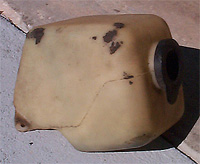
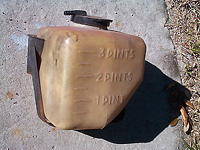 The 1970 washer fluid bottle on left is mounted directly
to the LF fenderwell while the 1971-2 washer bottle is held by a bracket
mounted to the LF fender just below where the hood meets the fender.
The 1970 washer fluid bottle on left is mounted directly
to the LF fenderwell while the 1971-2 washer bottle is held by a bracket
mounted to the LF fender just below where the hood meets the fender.
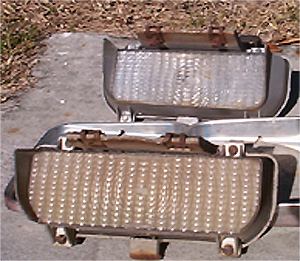 Here is a comparison of 1970 front marker light housing with
a 1971-2 (top) . The 1970 is about 1.5" wider than the 1971-2 version
and can not be interchanged.
Here is a comparison of 1970 front marker light housing with
a 1971-2 (top) . The 1970 is about 1.5" wider than the 1971-2 version
and can not be interchanged.
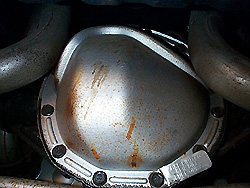
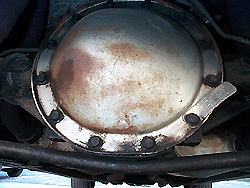 This is a side by side comparison of the two different 12
bolts that are found in A-bodies. The one on the left is a 12 bolt Chevrolet
and can be identified by the oil channel formed in the cover. Also, the
12 bolt Chevrolet is more oval in nature than the 12 bolt Olds on the right.
Olds used a smooth cover. Also, the Olds 12 bolt last appeared in 1970.
The 12 bolt Chevrolet last appeared in 1972. A note of interest is that
Canadian-built Skylarks have 12 bolt Chevrolet rear axles. To identify a
Canadian-built Skylark, look at the cowl tag in front of the windshield
wipers to see "MADE IN CANADA" at the bottom of the tag. Also,
notice both of these rears have a posi ID tag.
This is a side by side comparison of the two different 12
bolts that are found in A-bodies. The one on the left is a 12 bolt Chevrolet
and can be identified by the oil channel formed in the cover. Also, the
12 bolt Chevrolet is more oval in nature than the 12 bolt Olds on the right.
Olds used a smooth cover. Also, the Olds 12 bolt last appeared in 1970.
The 12 bolt Chevrolet last appeared in 1972. A note of interest is that
Canadian-built Skylarks have 12 bolt Chevrolet rear axles. To identify a
Canadian-built Skylark, look at the cowl tag in front of the windshield
wipers to see "MADE IN CANADA" at the bottom of the tag. Also,
notice both of these rears have a posi ID tag.
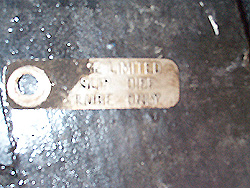 Here is the posi ID tag. The wording is "USE LIMITED
SLIP DIFF LUBE ONLY"
Here is the posi ID tag. The wording is "USE LIMITED
SLIP DIFF LUBE ONLY"
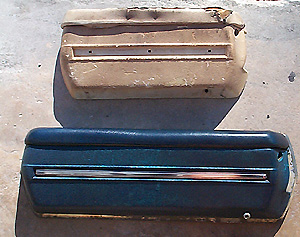 Here is a comparison of 1970 and earlier 16" armrest
(bottom) with 1971-2 12" armrest (top). The 16" versions are not
being reproduced so they are getting difficult to find. The 12" are
available as reproductions and run about $20-25 each. As you can tell in
this photo, the 12" is severly degraded and very brittle. No way to
save this one except to replace it with a new one.
Here is a comparison of 1970 and earlier 16" armrest
(bottom) with 1971-2 12" armrest (top). The 16" versions are not
being reproduced so they are getting difficult to find. The 12" are
available as reproductions and run about $20-25 each. As you can tell in
this photo, the 12" is severly degraded and very brittle. No way to
save this one except to replace it with a new one.
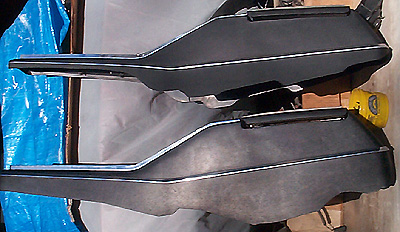 Here is side by side comparison of 1973-77 Regal center console(lower)
and 1970-2 Skylark center console (upper). The consoles are identical above
the stainless steel belt line. The lower portion on the Regal version is
much taller and these can be made to fit in 1970-2 Skylarks by trimming
with a sawz-all or jigsaw. The shifter and shifter cable from the Regal
will not work in a 70-2 Skylark. The Regal shifter handle is the same as
the 1970-2 versions except the handle is black while the 1970-2 handle is
a simulated woodgrain. The Regal shifter handle can be used in the 1970-2
Skylarks.
Here is side by side comparison of 1973-77 Regal center console(lower)
and 1970-2 Skylark center console (upper). The consoles are identical above
the stainless steel belt line. The lower portion on the Regal version is
much taller and these can be made to fit in 1970-2 Skylarks by trimming
with a sawz-all or jigsaw. The shifter and shifter cable from the Regal
will not work in a 70-2 Skylark. The Regal shifter handle is the same as
the 1970-2 versions except the handle is black while the 1970-2 handle is
a simulated woodgrain. The Regal shifter handle can be used in the 1970-2
Skylarks.
 This is a photo of a 67 disc brake hub cap similar in style
to the ones found on Corvettes of the same year.
This is a photo of a 67 disc brake hub cap similar in style
to the ones found on Corvettes of the same year.
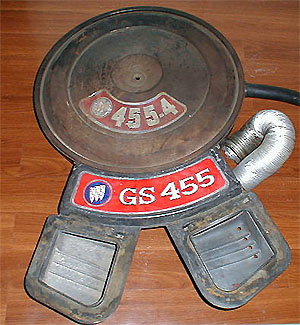 Here is a picture of a 1970-1 GS air cleaner. Note the 455-4
decal on the lid, this is incorrect for GS models. Also note the scoops
are both squares. In 1972, the driver's side or right one in this photo
would be a triangle which was changed to account for the introduction of
the AIR pump which was located above the ps pump on the driver's side.
Here is a picture of a 1970-1 GS air cleaner. Note the 455-4
decal on the lid, this is incorrect for GS models. Also note the scoops
are both squares. In 1972, the driver's side or right one in this photo
would be a triangle which was changed to account for the introduction of
the AIR pump which was located above the ps pump on the driver's side.
 This is a 1970 GS grille. The waffle area can be painted
black or silver. The gille uses 3 pieces of stainless trim to outline the
grille. The lower lip has a piece that is body colored that mounts to the
lip using four screws (4 screw holes seen in the photo.)
This is a 1970 GS grille. The waffle area can be painted
black or silver. The gille uses 3 pieces of stainless trim to outline the
grille. The lower lip has a piece that is body colored that mounts to the
lip using four screws (4 screw holes seen in the photo.)
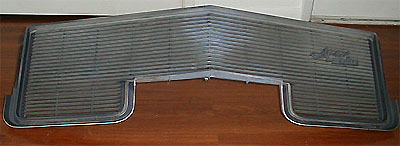 This is a 71 Skylark grill and they are getting very difficult
to find. It is all plastic just like the 70 GS grille.
This is a 71 Skylark grill and they are getting very difficult
to find. It is all plastic just like the 70 GS grille.
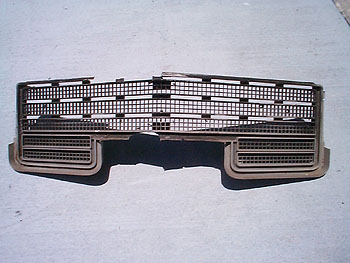 This is a 71 GS grille and is made of plastic. This one is
missing a portion of the upper horizontal rib. The design is similar to
the 72 Skylark Custom grille below.
This is a 71 GS grille and is made of plastic. This one is
missing a portion of the upper horizontal rib. The design is similar to
the 72 Skylark Custom grille below.
 This is a 72 Skylark Custom grill and is made from pot metal.
This is a 72 Skylark Custom grill and is made from pot metal.
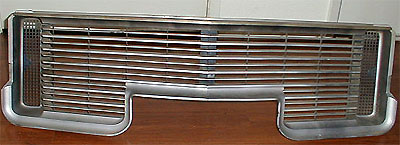 This is a 72 Skylark and GS grille. It is all plastic. Thankfully
Skylark and GS used the same grille so these are a little easier to find.
This is a 72 Skylark and GS grille. It is all plastic. Thankfully
Skylark and GS used the same grille so these are a little easier to find.
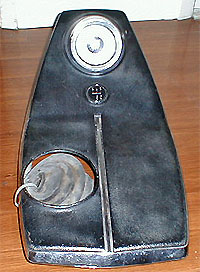 This is a 4 speed consolette and is found on 1968-72 cars.
They are identical for each year. The round portion at the top was used
for tachs in 1968-9 since there was no place to install a tach in the instrument
cluster.
This is a 4 speed consolette and is found on 1968-72 cars.
They are identical for each year. The round portion at the top was used
for tachs in 1968-9 since there was no place to install a tach in the instrument
cluster.
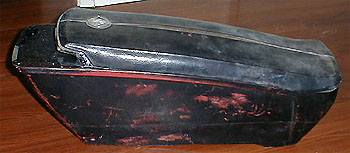 This is a medium console and was placed between buckets for
column shifted cars or 4 speed cars.
This is a medium console and was placed between buckets for
column shifted cars or 4 speed cars.
 This is a 1968-9 console and is quite different than the
1970-2 versions.
This is a 1968-9 console and is quite different than the
1970-2 versions.
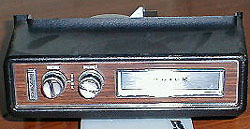
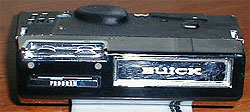 Here are a couple 8 track players. The one on the left is
from 1972. They were mounted to the bottom of the dash.
Here are a couple 8 track players. The one on the left is
from 1972. They were mounted to the bottom of the dash.
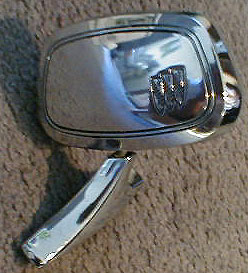 This is a 1970 driver's side mirror. The tri-shield found
on the back of the mirror head was only used in 1970. In 1971-2, the mirror
did not have the tri-shield.
This is a 1970 driver's side mirror. The tri-shield found
on the back of the mirror head was only used in 1970. In 1971-2, the mirror
did not have the tri-shield.
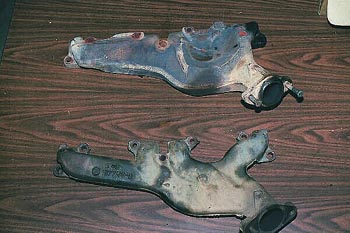 The top manifold is from a 73 455 car and is typical of 1968-up
exhaust manifolds. The depression between #5 and #7 exhaust ports was to
clear the power brake booster. The manifold on the bottom is from a 67 430
car and does not have the depression. The bottom manifold actually flows
better, they are sought after by stock appearing racers for better performance.
The top manifold is from a 73 455 car and is typical of 1968-up
exhaust manifolds. The depression between #5 and #7 exhaust ports was to
clear the power brake booster. The manifold on the bottom is from a 67 430
car and does not have the depression. The bottom manifold actually flows
better, they are sought after by stock appearing racers for better performance.
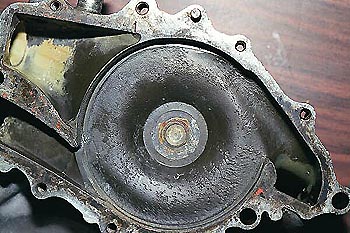 This is a good example showing what happens when you run
water for coolant. Always run anti-freeze or suitable fluid for coolant
since the timing cover will erode with water use and lead to pinhole leaks.
This is a good example showing what happens when you run
water for coolant. Always run anti-freeze or suitable fluid for coolant
since the timing cover will erode with water use and lead to pinhole leaks.
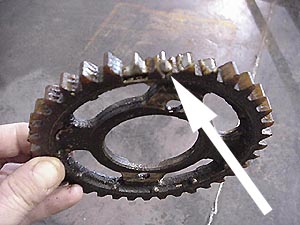 This is the factory cam sprocket. As the arrow indicates,
the nylon portion has worn away. This is very dangerous as the nylon particles
soon collect in/on the oil pick-up screen and leads to oil starvation. Engine
failure occurs soon after. Replace with a double roller chain and gears!
This is the factory cam sprocket. As the arrow indicates,
the nylon portion has worn away. This is very dangerous as the nylon particles
soon collect in/on the oil pick-up screen and leads to oil starvation. Engine
failure occurs soon after. Replace with a double roller chain and gears!
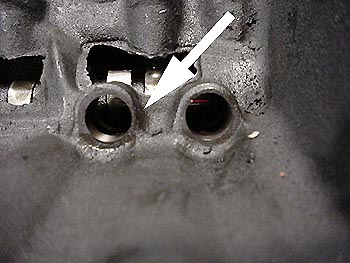 This is an example of core shift during casting and leads
to a weak block. This may be fine for regular street car but any type of
performance build up would lead to structural failure in this block. There
is very little material to hold the lifter in place and this block should
be discarded in favor of another block.
This is an example of core shift during casting and leads
to a weak block. This may be fine for regular street car but any type of
performance build up would lead to structural failure in this block. There
is very little material to hold the lifter in place and this block should
be discarded in favor of another block.
 Here is a pic of two rear defrosts. The top one is from 1970
and has a metal grille. The lower is from 1971-2 and has a plastic grille.
Here is a pic of two rear defrosts. The top one is from 1970
and has a metal grille. The lower is from 1971-2 and has a plastic grille.
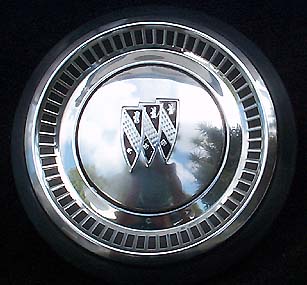 Here is pic of the standard hubcaps called "dog dish"
or "poverty" caps. Early versions were chrome plated steel and
later ones were aluminum.
Here is pic of the standard hubcaps called "dog dish"
or "poverty" caps. Early versions were chrome plated steel and
later ones were aluminum.
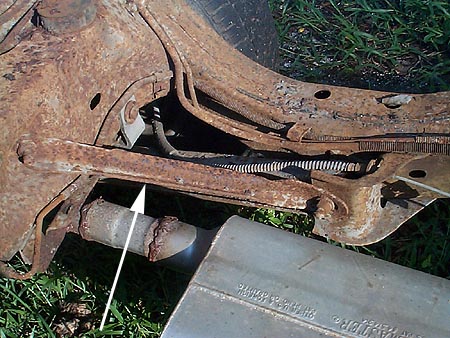 The arrow indicates the rear frame reinforcement bracket.
It is mounted
to the frame using the upper and lower control arms for the
rear axle.
These are usually found on performance models such as GS,
GTO, 442, SS.
The arrow indicates the rear frame reinforcement bracket.
It is mounted
to the frame using the upper and lower control arms for the
rear axle.
These are usually found on performance models such as GS,
GTO, 442, SS.
 Here is a pic showing the VIN on a TH400 for a 70 GS455.
Here is a pic showing the VIN on a TH400 for a 70 GS455.






























